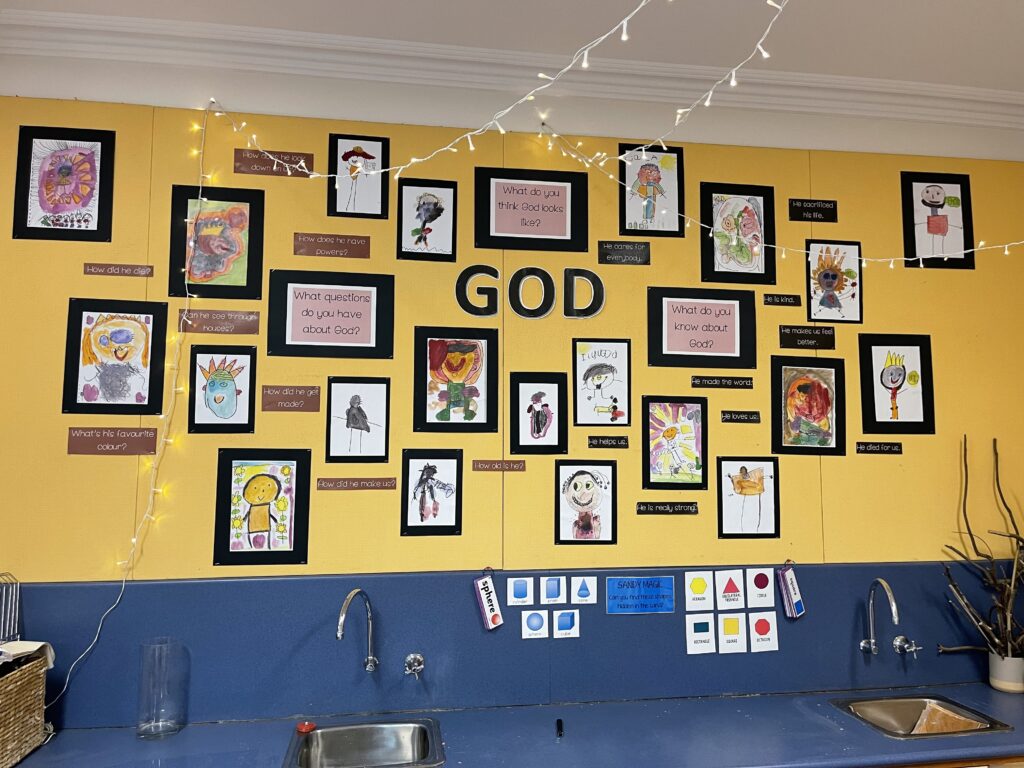Invocations Prayers & Blessings
“We ought always to thank God for you, brothers and sisters, and rightly so, because your faith is growing more and more, and the love all of you have for one another is increasing.”
2 Thessalonians 1:3

Invocations
We begin worship and devotions with the Invocation. The term comes from the Latin word invocare, which means ‘to call upon.’ In the invocation, we are calling on God to be present.
Matthew 18:20 says, “For where two or three are gathered together in my name, there I am in the midst of them.” When we ask God to be present, we have his promise that he will be. The invocation also reminds us of baptism, when people become part of God’s family. The words used are the same as in baptism. “Therefore go and make disciples of all nations, baptising them in the name of the Father and of the Son and of the Holy Spirit.” Matthew 28:19
The invocation can be simple and straightforward:
‘In the name of the Father and of the Son and of the Holy Spirit.’
Alternative forms include:
“Glory to the Father and the son and the Holy Spirit, Amen.”
“Glory to the Father and the Son and the Holy Spirit.
As it was in the beginning, is now, and ever more will be, Amen.”
“In the name of the Father: Who sent us Jesus.
In the name of the Son: Who died for us.
And in the name of the Holy Spirit: Who helps us
to live as God’s children. Amen.”
The invocation can be adapted to fit the theme or message of the day. For example, for the story of Moses and the Burning Bush, you could begin with:
“In the name of God who calls us to live a life of purpose,
Jesus who selflessly gives of himself for the benefit of others,
And the Spirit who empowers us to achieve what God has set out for us to do. Amen.”
Alternatively, you could choose a verse from the Bible reading to say responsively, followed by the usual invocation:
God called to Moses out of the bush: ‘Remove the sandals from your feet,
for the place on which you are standing is holy ground.‘ (Exod 3:5 NRSV)
In the name of the Father and of the Son and of the Holy Spirit. Amen.
Note: in Lutheran worship, we always call on the Triune God (the Father, Son and Holy Spirit). This is because our focus is on calling on the name of the Lord, and on remembering our baptism. In other traditions, services often begin with a “Call to Worship”, which centres more on calling believers to come to worship. If using online prayer resources, be mindful of this distinction.

Prayers
Lutheran schools provide a great opportunity to foster communal and individual prayer… Prayer will be part of the formal school worship and also daily devotions in the classroom. The day may begin and end in prayer, grace said before the lunch meal, opportunities to pray for members of the class, at birthdays, in times of difficulty, giving thanks for good things which have happened.
– Malcolm Bartsch, 2013, A God who speaks and acts, p 236
Prayers in worship
In worship, we pray prayers of request and thanks. The prayers often begin with a connection to the readings or the core message of the service, and then go on to include prayers for the learning community and the world.
Prayers in Devotions
Prayers in devotions are an opportunity to reflect on the readings that have just been heard, and to pray for the specific concerns of the students.
Devotions are a great time to combine some set prayers (such as the Lord’s Prayer or Luther’s Morning Prayer) with the spontaneous prayers of the group.
Mealtime Prayers
In our Lutheran tradition many of us start mealtimes together with prayers such as “Come Lord Jesus be our guest and let this food to us be blessed. Amen.”
Jesus is with us even if we don’t ask him to be present. But, trusting in his promise, we are asking him to come and be our guest and be present with us. Jesus truly is the unseen guest at our tables, and he desires to minister to us with his grace. You can find lots of mealtime prayers (table graces) on the Christian Practices page.
,
Teaching students to pray
Prayer doesn’t have to be elaborate or follow a set pattern – it can be simple heartfelt expressions of our thoughts and concerns shared with our loving God. Prayer can be silent and personal or a communal experience where a group joins together to pray, or a combination of these.
While prayer can be simple , students (and adults) can sometimes find it helpful to learn different ways to pray, which provide some scaffolding and can make it easier to pray together. These include:
- classic short prayers learnt off-by-heart (eg the Lord’s Prayer, table graces etc)
- prayers from the Bible – there are many prayers in scripture.
For example, from Psalm 51:1-2, “Be merciful to me, O God,
because of your constant love.
Because of your great mercy
wipe away my sins!
Wash away all my evil
and make me clean from my sin!”
- action prayers which help students remember what to pray for (eg The Five Finger Prayer)
- creative prayer patterns/styles (eg popcorn prayers, drawing prayers, colouring prayers etc)
Older students may enjoy prayer journalling, prayerful meditation or small group prayer.
Prayer Resources
GROW Ministries
GIFT – Prayer – detailed kit with lots of ideas and activities for teaching children to pray and incorporating prayer into worship. Includes two skits and numerous creative prayer activities.
Nurturing faith through prayer – helpful article about teaching prayer, especially to younger students.
Lutheran Tract Mission
My Book of Prayers for young children Great booklet to keep on a ECS or junior primary classroom altar.
Other Resources
I Can Learn to Pray by Holly Hawkins Shivers – 52 devotions teaching children to pray.
Prayer: Learning How to Talk to God by Jeannette Groth
10 Ways to Pray With Kids – Illustrated Ministries article. Includes some good ideas for teaching prayer.

The Lord’s Prayer
In response to the request of his disciples to teach them to pray, Jesus gave his own prayer to his followers (Mt 6:9-13; Lk 11:1-4).
Resources for Sharing the Lord’s Prayer
Lutheran Tract Mission
Learning the Lord’s Prayer – an activity book for Primary school students which helps them learn and reflect on the Lord’s Prayer.
The Lords Prayer and Explanations – suitable for upper primary and secondary students, includes the Small Catechism explanations of each petition.
Growing Together as Family – The Lord’s Prayer – a 16 page leaflet with 4 weeks of devotions about the Lord’s Prayer. Although intended for families, could be easily adapted for classroom use.
Lutheran Tract Mission also have a selection of bookmarks and notecards featuring the Lord’s Prayer.
Musical versions
MOTIONS (The Lord’s Prayer) – Saddleback Kids
The Lords Prayer Music Video – with actions
The Lord’s Prayer – Hillsong Worship
The Lord’s Prayer – Andrea Bocelli – ft. The Tabernacle Choir at Temple Square Lovely animation, would suit a reflective time.
Action Prayers
Moving our bodies often helps us to remember information and connect to its meaning. You can use movement in prayers to help focus the heart and to remember what to pray for.
Prayer Posture – see the Rituals and Routines page.
Five-finger prayers
Use five fingers to remind you of five kinds of prayer.
Praise – tell God how great He is
Thanks – thank God for what He does
Confession – tell God about things that you are sorry about
Petition – ask God to help you
Intercession – ask God to help other people
OR
Use five fingers to remind you of who to pray for.
Little finger: weak, poor, sick and helpless people
Ring finger (with a special link to your heart): your family and other people you Jove
Middle finger (the tallest): leaders of your community, nation and the world
Pointer finger: people who point the way for you, e.g. teachers
Thumb (that bends back toward you): yourself
(From Grow Ministries article, “Nurturing faith through prayer”, 6 April 2017)
Prayer beads
More commonly used in the Catholic tradition, prayer beads can help students to remember where they are up to in a longer prayer or who or what to pray for. Create your own set of prayer beads with symbols which help to remember each petition of the Lord’s Prayer, the people or issues you want to pray for, etc. As you pray, hold and touch each bead in turn, praying as you go.
Creative Prayer Ideas
Prayer Stations
Setting up prayer stations for worship or devotions can be a great way for students to engage with prayer at their own pace and in their own style.
Prayer stations can be indoor or outdoor. You could set up a series of tubs and stimulus cards, ready to pull out and use on a regular basis or to swap with other classes.
Some ideas for prayer stations:
- Listening and reflecting – have headphones and some reflective music for students to listen to while they respond to a prayer stimulus, like “Pray for peace in your life and in the world”.
- Globe station – have students pray for the needs of different places in the world.
- A Blessing Tree – write prayers of thanks and to bless others, and add to a ‘tree’ (branches in a large vase).
- Pray in colour station
See the Creative Devotions Ideas and Creative Worship Ideas pages for more suggestions.
Teach Sunday School has a useful Printable Prayer Stations page.
Christian Meditation
Pray as you go – Scottish Jesuits – daily audio meditations, plus a few videos, and some prayer practices explained. Beautiful video prayer meditation is highly recommended.
Praying in Colour/Creative Response
Praying in Colour – website with resources for praying while doodling. Includes free printable resources and instructions about how to teach this method of prayer. This can be a good way to occupy busy hands and quieten minds.
Illustrated Ministries has some excellent resources for individual and collaborative colouring posters suitable for all ages.
Prayer Journalling
Labyrinths and Prayer Walks
For more information on these reflective prayer activities, visit the Creative Devotion Ideas page.
Blessings
The Lord said to Moses, “Tell Aaron and his sons, ‘This is how you are to bless the Israelites. Say to them: “The Lord bless you and keep you; the Lord make his face shine on you and be gracious to you; the Lord turn his face toward you and give you peace.”’ “So they will put my name on the Israelites, and I will bless them.” Numbers 6:22-27
At the close of worship or devotions, we get ready to go back out into the world. Just as we called on God to gather us at the beginning of the devotion or worship, now we ask God to send us out in his strength.
This blessing is more than wishful thinking. It is God promising his presence with us throughout our everyday lives. God says, ‘go therefore and make disciples of all nations….’ We can go out with confidence.
You might like to encourage the students and staff to bless each other at the end of the devotion time. Use simple words, and include a simple gesture like making a cross on each other’s forehead or arm.“God bless you today [name]”;
“Jesus loves you, [name]. Have a great day!”
Just as the invocation can be adapted to suit the reading or message of the day, the blessing can also be adapted to reinforce the central message.
Using the Moses and the Burning Bush example from earlier, the blessing could be:
Go with the knowledge that God has called you to a mission greater than yourself, to serve and help others. Go inspired by the example set by Jesus, who humbly and without hesitation sacrificed himself for the sake of those who were in trouble. Go empowered by the Spirit to act in confidence and without the constraints of fear and doubt. Amen.
OR
(Name), know that God promises to be with you always.
You will find suggested blessings in each of the Bible Story Resources.




